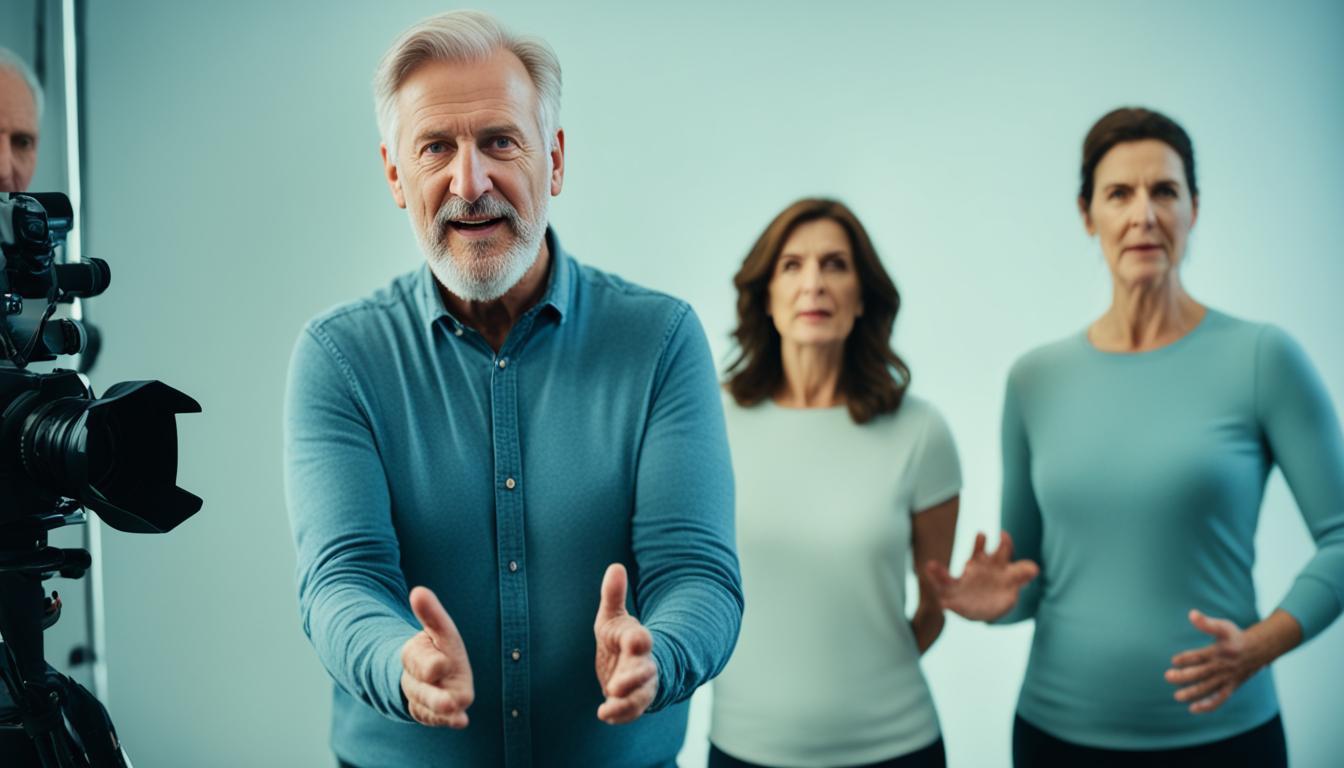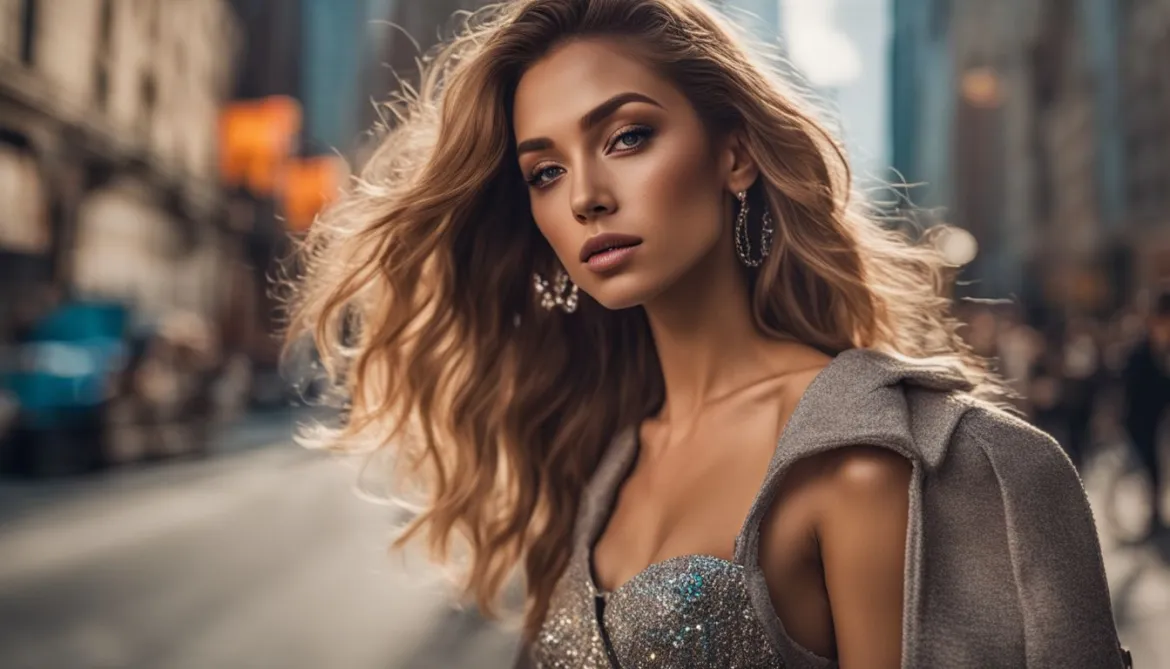Working with non-models in photography can be a challenge, but with practice and experience, it becomes a valuable skill that can greatly enhance your work. When directing non-models, clear and confident communication is essential to ensure successful shoots and captivating portraits.
As photographers, we need to be mindful of our language and use specific directions to guide our subjects effectively. Physically demonstrating poses and providing information about lighting and framing can also enhance the shoot and help the non-models understand and execute your vision.
It’s important to prioritize the comfort of the models and avoid poses that may strain them. By maintaining a relaxed and enjoyable atmosphere, we can foster a collaborative environment that allows for effective communication and feedback.
Key Takeaways:
- Clear and confident communication is vital when directing non-models.
- Physically demonstrating poses and providing information about lighting and framing can enhance the shoot.
- Be mindful of the model’s comfort and avoid strenuous poses.
- Continuous communication and feedback help create a successful and collaborative photo shoot.
- Developing strong directing skills can greatly enhance your portrait photography.
The Importance of Clear and Confident Communication
When working with non-models, it’s crucial to deliver directions that are clear and confident. Clear and confident communication is the cornerstone of effective directing. As photographers, it’s important to practice directing subjects until we feel comfortable and self-assured in our instructions.
Speaking loudly enough for the model to hear us is essential, as they won’t be able to follow our directions if we’re talking quietly. We must ensure that our words are clearly articulated and well-projected, allowing the model to understand and execute the poses correctly.
Moreover, we need to be mindful of our language and use polite and respectful terms when communicating with our subjects. This creates a comfortable and professional environment, making the model feel valued and at ease during the shoot.
While delivering directions, it’s essential to focus on providing specific instructions that are easy to understand. Instead of generalized statements like “pose naturally,” we can guide the subject with clear and concise directions, such as “tilt your head slightly to the left” or “bend your arms at a 90-degree angle.”
Sometimes, words alone may not be enough to convey the desired pose. Physically demonstrating poses can be a powerful tool in our directing arsenal. By showcasing the pose ourselves, we provide a visual reference for the model, making it easier for them to understand and replicate.
“Clear and confident communication is the bridge that connects our vision to the subject’s ability to pose effectively.”
Table: Key Elements of Clear and Confident Communication
| Elements of Clear and Confident Communication | Description |
|---|---|
| Clarity | Using precise and specific instructions |
| Confidence | Demonstrating authority and self-assuredness |
| Volume | Speaking loudly enough for the model to hear |
| Mindfulness | Using polite and respectful language |
| Physical Demonstration | Visualizing poses for the subject |
By prioritizing clear and confident communication, we ensure a streamlined and productive photoshoot, leading to stunning results. Let’s remember that directing non-models requires patience, understanding, and effective communication skills to unleash their full potential in front of the camera.
Providing Information about Lighting and Framing
When working with non-models in portrait photography, it’s essential to provide them with information about the lighting set-up and framing. This knowledge helps guide their poses and enables them to better understand your vision as a photographer.
If you are using artificial lights, it’s important to explain which light serves as the key light. This light source will have the greatest influence on the subject’s appearance and overall mood of the photograph. By sharing this information, you empower the model to position themselves in a way that optimizes the lighting and brings out their features.

When working with natural light, be sure to explain the direction of the light to the model. This helps them understand where the light is coming from and how it will impact their pose and overall look. By informing them about the lighting conditions, you provide them with valuable insights that contribute to a successful shoot.
In addition to lighting, it’s crucial to explain your framing and composition choices to the model. While you may have a clear vision in your mind, the model can’t see what the camera sees. By describing your intended framing and composition, you offer them the context they need to pose in a way that aligns with your vision.
In summary, providing information about lighting set-up and framing is vital in directing non-models during a portrait photography session. By communicating this information effectively, you empower the model to make informed decisions about their poses, resulting in photographs that capture your creative vision and showcase the model’s unique beauty.
Maintaining Comfort and Avoiding Strenuous Poses
As a photographer, one of our top priorities is ensuring the model’s comfort during the shoot. We understand that models may be hesitant to express their discomfort or exhaustion from holding strenuous poses for extended periods. To create a positive and enjoyable experience, it’s crucial to avoid having them hold physically challenging poses for too long.
One effective technique is allowing poses to “reset.” We encourage the model to come out of the pose, take a brief moment to relax, and then re-enter it. This prevents the poses from looking stale and helps maintain a natural and fresh appearance throughout the shoot.
Being mindful of the model’s comfort not only shows our professionalism but also creates an environment where they can perform at their best. We want our models to feel relaxed and confident, which ultimately translates into stunning photographs.
In addition to avoiding strenuous poses, we can also take small breaks during the shoot to give the model a chance to rest and recharge. These breaks can be an opportunity to review images on the camera’s preview screen and provide positive feedback. Celebrating their accomplishments and offering encouragement can boost their confidence and keep the energy levels high.
Remember, a comfortable and enjoyable shoot not only benefits the model but also contributes to the overall success of the project. By prioritizing the model’s comfort and well-being, we can capture authentic and captivating images.
| Tip | Description |
|---|---|
| Communicate openly | Regularly check in with the model to ensure they’re comfortable and address any concerns they may have. |
| Offer breaks | Introduce short breaks during long shoots to allow the model to rest and recharge. |
| Provide seating | Have a comfortable chair or stool on set where the model can sit in between poses. |
| Keep the temperature comfortable | Ensure the shooting location is neither too hot nor too cold, as this can affect the model’s comfort and performance. |
| Provide refreshments | Offer water and snacks to keep the model hydrated and energized throughout the shoot. |
Effective Communication and Feedback
Communication plays a pivotal role in the success of a photo shoot, especially when it comes to directing models. As photographers, it is essential to establish effective communication channels with our subjects to ensure a smooth and productive session. By continuously talking to the model and providing feedback, we can guide them towards achieving the desired poses and expressions.
During the shoot, it is crucial to update the model on the progress and let them know when we’ve captured a great shot. This communication helps them understand our vision and builds their confidence in the process. Additionally, providing constructive feedback and positive instruction is vital because models may not always be aware of how they appear on camera.
“Photography is the story I fail to put into words.”
– Destin Sparks
An effective way to provide feedback is by showing the images on the camera’s preview screen. This enables models to visualize their performance and make adjustments if needed. Encouraging them to experiment and try different poses while offering feedback in real time fosters a collaborative and empowering environment.
While communicating with models, it’s essential to maintain a professional yet friendly demeanor. Being approachable and creating a relaxed atmosphere can help models feel more comfortable and at ease. This positive energy translates into better results as they become more open to direction and feedback.

Benefits of Effective Communication:
- Improved understanding: Clear communication ensures that models comprehend your instructions and align their actions accordingly.
- Enhanced collaboration: By actively involving models in the creative process, you foster collaboration and encourage their creative input.
- Empowered models: Providing feedback and guidance builds models’ confidence and empowers them to excel in front of the camera.
- Efficient workflow: Effective communication streamlines the workflow, reduces re-takes, and saves time during post-production.
Embracing effective communication and feedback techniques not only enhances the photographer-model relationship but also improves the overall quality of the photo shoot. By fostering clear and open lines of communication, we can create captivating images that capture the essence of our vision.
Conclusion
Working with non-models in professional photography requires practice, but it is an invaluable skill that can greatly enhance your portrait photography. By employing clear and confident communication, along with mindful language and specific directions, photographers can create a comfortable shooting environment for their subjects.
Physically demonstrating poses and providing information about lighting and framing can further ensure that the non-models understand the vision and objectives of the shoot. It is essential to be considerate of the model’s comfort and avoid asking them to hold strenuous poses for extended periods, as their well-being should always be a priority.
In addition to effective communication, providing feedback to the models is crucial for capturing the desired shots. Offering positive instruction and showing them the images on the camera’s preview can boost their confidence and allow for necessary adjustments. By developing these directing skills and maintaining a professional yet relaxed demeanor, photographers can create enjoyable and productive photo shoots.
In conclusion, professional photography involves not only technical expertise but also the ability to work with subjects and direct non-models effectively. By incorporating these strategies into your practice, you can elevate your portrait photography and create stunning images that truly capture the essence of your subjects.
FAQ
What are some tips for directing non-models during a photoshoot?
When working with non-models, it’s important to deliver directions that are clear and confident. Practice directing subjects until you feel comfortable and self-assured.
How can I communicate effectively with non-model subjects during a shoot?
Speak loudly enough for the model to hear you and use polite and respectful language. Focus on delivering specific directions that are easy to understand, and consider physically demonstrating poses if necessary.
Should I provide information about lighting and framing to non-model subjects?
Yes, providing information about the lighting set-up and the direction of the light can help guide non-model subjects as they pose. Additionally, explaining your framing and composition will help them better understand your vision.
How can I ensure the comfort of non-model subjects during a shoot?
Be mindful of the model’s comfort and avoid having them hold poses that are physically challenging for extended periods. Allow poses to “reset” by having the model come out of the pose, relax, and then re-enter it.
What is the importance of effective communication and feedback during a photoshoot with non-models?
Continuous communication, feedback, and updating the model on the progress of the shoot are crucial. Providing positive instruction and showing them the images on the camera’s preview can boost their confidence and allow for necessary adjustments.
Why is directing non-models an important skill for photographers?
Directing non-models is an essential skill for photographers as it can greatly improve portrait photography. It allows photographers to effectively communicate their vision and create stunning images with subjects who may not be experienced models.
Can I Apply the Golden Hour Photography Essentials When Directing Non-Model Subjects?
When directing non-model subjects, applying golden hour photography tips can still be beneficial. Utilize soft, flattering light and warm tones to bring out the best in your subjects. Take advantage of the golden hour’s magical atmosphere to create stunning portraits, even with non-model subjects.




